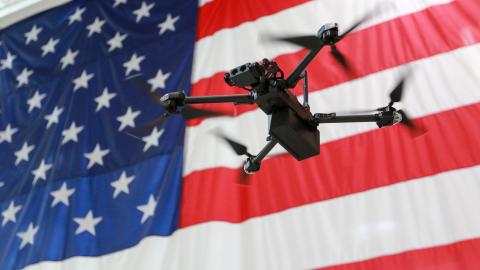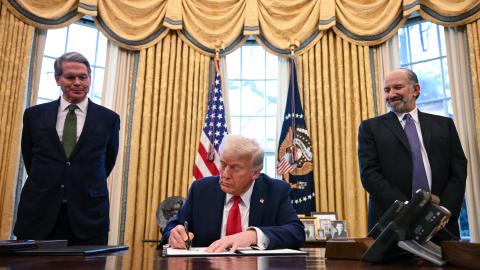Eighty years after aircraft carriers became the capital ship of great seafaring nations, China's third carrier is making waves. Fujian, named for the province bordering the Taiwan Strait, far surpasses the capabilities of China's two other carriers, Liaoning and Shandong, based on the Russian Admiral Kuznetsov-class design and commissioned in the past decade.
The 80,000-tonne Fujian launched in June is China's first indigenously designed carrier - built from the keel up and outfitted with an electromagnetic catapult to conduct rapid, sustained air sorties. Advanced radar and communications systems will likely complement a composite airwing of up to 50 J-15B fighters or J-35 stealth fighters, electronic combat aircraft, helicopters as well as drones.
But China is just getting started.
Even as the People's Liberation Army (PLA) Navy readies the Fujian to enter active service over the next couple of years, work is possibly under way on a 100,000-tonne, nuclear-powered behemoth similar to US Nimitz- and Ford-class supercarriers. By adding three or more of this future carrier class by the mid-2030s, China could encircle Taiwan with hostile airpower and bolster its power projection in far seas operations. The same platform that might pronounce the end of America's post-war naval superiority in the Western Pacific may establish China's status as a "great maritime power".
Beijing is going to great lengths to commandeer the symbol of American naval superiority to defend its sovereign claims, protect its overseas interests and deliver the China dream.
To understand what the Fujian represents for China, the region and the world, it is helpful to recall the mission of the most prized naval platforms.
From the Battle of Trafalgar to Pearl Harbor
All-big-gun warships have dominated the seas since the Age of Sail, dating back to the 17th century. HMS Victory, Lord Nelson's flagship at the 1805 Battle of Trafalgar, was a 104-gun first-rate ship of the line. As the industrial age progressed, Victory's descendants brandished bigger guns and steam propulsion, making battleships the most coveted naval combatant.
The Anglo-German naval arms race preceding World War I centred on dreadnoughts, as battleships came to be known from 1906 when the British established a new standard for warships with the deployment of HMS Dreadnought. Although the British introduced an early carrier prototype during the Great War, HMS Furious' air operations were more adept at reconnaissance than strike missions.
On Dec 7, 1941, aircraft carriers emerged as the unparalleled capital ship when all six of Imperial Japan's first-line carriers, embarking more than 420 aircraft, executed a surprise attack on Pearl Harbour. But America's decision to invest heavily in shipbuilding allowed the US Navy to build back a better and more extensive fleet.
The steady production of a brand-new class of light, fast carriers, Essex, would begin joining the Central Pacific Command in 1943. The tide was about to turn in the Pacific War. By V-J day on Sept 2, 1945, the United States Navy's order of battle comprised an astonishing 6,768 ships, including 28 aircraft carriers and another 71 escort carriers built on commercial hulls.
The same capital ship that had devastated the US Navy in 1941 was now the principal platform for projecting American power in the post-war world. "The largest aircraft carrier force in history," historian Paul Kennedy writes in Victory At Sea, established "a new order of sea power that completely eclipsed the four-hundred-year era of the all-big-gun warship".
A Vessel With Multiple Roles
Aircraft carriers allowed the US reliable, flexible air bases adjacent to war zones, such as when North Korean forces nearly overran South Korea in 1950. They have allowed the US to reassure allies and signal political resolve. The peaceful passage of carriers through and near the Taiwan Strait, the South China Sea, and
the East China Sea attests to the power of carrier-led naval presence. Conversely, Britain's 1968 decision to abandon military commitments East of Suez coincided with a weakened economy and naval force.
Access to friendly ports or overseas bases has always been vital to foreign naval operations, including peacetime presence and deterrence roles.
Homeporting a carrier in Yokosuka, Japan, as part of the Seventh Fleet reassures allies that the US remains fully committed to maintaining the peace and helps deter aggression.
After the Philippines ordered the US Navy to leave Subic Bay in 1992, Singapore stepped up to keep the US engaged by agreeing to house the logistics agent for the Seventh Fleet in the form of Commander, Logistics Group Western Pacific. A decade later, in 2001, the USS Kitty Hawk (to which the Fujian is likened) made the inaugural port visit by an aircraft carrier to the new deep-draft vessel pier at Changi Naval Base.
Even before the proliferation of long-range, precision-guided missiles, large surface ships have been priority targets once hostilities start.
The vulnerability of capital ships prompted some naval visionaries more than a century ago to imagine that a "submersible battle cruiser" would become tomorrow's capital ship.
China launches its most advanced aircraft carrier amid rising tension with US
US losing its military edge in Asia, and China knows it
Submarines and undersea warfare remain a distinct US advantage vis-a-vis the PLA Navy. Still, leaders in Beijing are hoping to emulate the US Navy's aircraft carrier experience - co-opting the quintessential expression of American seapower to advance China's great rejuvenation.
President Xi Jinping aspires to consolidate China's leading place in the world. If his visit to Hong Kong illustrates his determination to safeguard territorial claims regardless of dissent, his commitment to an oceanic navy spearheaded by aircraft carriers shows his unwillingness to brook interference from the US Navy.
The PLA Navy is already "the largest navy in the world" and is on course to widen its numerical superiority and narrow the US Navy's qualitative edge. And this maritime expansion exists as part of "the world's biggest military build-up… since World War II", according to Admiral John Aquilino, head of the US Indo-Pacific Command.
The Threat to Taiwan
Thoughts about how the US Navy will deal with China's emergence as a great maritime nation gravitate around potential conflict over Taiwan. A carrier named Fujian amplifies this fear. The acquisition of carrier-killing missiles as part of an anti-access and area-denial strategy that includes submarines and land-based aircraft is aimed at dissuading the US from sailing capital ships near Taiwan. As retired Rear Admiral Michael McDevitt observes in China As A 21st Century Naval Power, "for the PLA, the farther the carrier is from the Taiwan Strait, the better".
Today China is closer to using aircraft carriers in a Taiwan scenario, threatening to encircle the island with hostile air power as a psychological sword of Damocles hanging over the heads of the people of Taiwan, either by imposing a crushing embargo or using the floating airbases to launch a punishing air campaign.
Admiral Liu Huaqing, often referred to as "the father of China's aircraft carrier", argued in 1986 that carriers were essential for "the recovery of the Nansha (Spratly Islands) and the reunification of Taiwan".
China's military using mock-ups of US aircraft carrier as targets
Chinese aircraft carrier group conducts exercise in South China Sea
While China's military thinking emphasises system v system warfare - rather than focusing on individual ships or exclusively military hardware - there is a gnawing fear that Beijing could miscalculate in a manner analogous to Russian President Vladimir Putin's miscalculation in attacking Ukraine.
The understandable pride accompanying the launch of new platforms like the Fujian could further embolden Chinese leaders to act suddenly on behalf of perceived vital interests. The PLA Navy has proven that it can transition from a coastal defence force to a modern bluewater navy. Mr Xi appears fully vested in the concept that a great maritime nation requires aircraft carriers as capital ships.
Will an intensifying competition embodied in the aircraft carriers lead to a collision over Taiwan?
US President Joe Biden has pledged to defend Taiwan if it is attacked because "that's the commitment we made". Mr Xi has a different but equally blunt commitment. As the 20th Party Congress approaches this autumn, he will increasingly consider his legacy in protecting China's core interests over what he considers Chinese sovereign territory. And as Mr Xi has frequently reminded the world, the raison d'etre of the PLA is to "win wars".
The allure and influence of capital ships are undeniable, but understanding the limits of their power may ultimately help keep the peace.
Read in The Straits Times

















